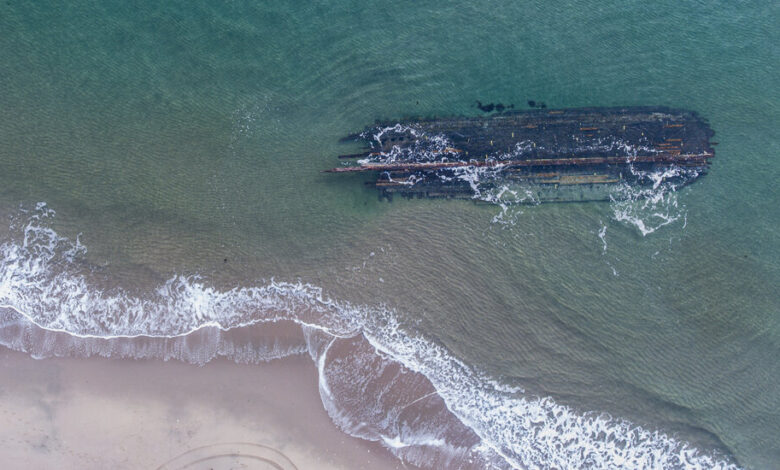
[ad_1]
Ever since a shipwreck washed ashore in the remote Canadian coastal area of Cape Ray on the island of Newfoundland in late January, it’s been causing a stir in the small community of about 250 people.
Residents have posed for pictures with parts of the wooden ship, which a local hunter spotted and which is believed to be from the 19th century. They’ve encouraged the authorities to secure the structure. And they’ve speculated on social media about its mysterious origins.
The posts, on a community page on Facebook, caught the attention of a local photographer, Corey Purchase, who lives 15 minutes from the area. He used a drone to take aerial photos showing the scale of the vessel, which he estimated to be about 90 feet long.
“The drone put it into perspective for sure,” he said. “It was a pretty amazing find.”
Shipwrecks in this region aren’t that uncommon. There have probably been thousands around the coast of Newfoundland in the past 500 years, said Jamie Brake, the provincial archaeologist.
“It has just such a long history of ship traffic,” Dr. Brake said. “Cape Ray, it’s an exposed, treacherous shoreline, with fog and reefs. There is a lighthouse now that protect mariners, but that wasn’t always there.”
Still, experts say that it’s rare for such a large ship to wash ashore in Cape Ray Cove, near the Gulf of St. Lawrence.
It’s possible that the ship was washed ashore by Hurricane Fiona, a Category 4 storm that destroyed about 100 homes along the coast of southwestern Newfoundland, from Port aux Basques eastward to Burgeo, said Neil Burgess, the president of the Shipwreck Preservation Society of Newfoundland & Labrador.
Mr. Burgess plans to survey the ship this weekend to learn more about its origins. Just from looking at the pictures captured by Mr. Purchase and others, he suspects it might be from the 1800s because of some construction details. For instance, it’s held together by large treenails, wooden pegs usually made of dry compressed timber, and copper pegs, which he said was common in ships of that era.
There have been about a dozen recorded shipwrecks in the Cape Ray area in the last three centuries, Mr. Burgess said. During a survey of the ship, he’s hoping to determine the type of wood used and how old it is. That way, there’s a better chance of identifying the shipwreck.
Such a discovery would be a “local victory,” he said.
“People have stories in their family of shipwrecks that have happened 100 or 150 years ago,” Mr. Burgess said. “It’s always a bit of a mystery to put a name to the shipwrecks that wash up on the beach.”
If nothing is done to manage the wreck it’s possible that it could be washed back out to the ocean or pushed further onto shore, he said.
What ultimately happens to the ship is up to the Provincial Archaeology Office. Dr. Brake said the office had not yet made an determination about next steps. He said they would look into the survey this weekend with an “open mind.”
In the past, the government has buried shipwrecks in the sand so that they can be preserved if someone wants to dig them up and research them at a later time.
Some people in Cape Ray, however, have posted on the Facebook community page that they hope the shipwreck can be used as some sort of tourist attraction. They feared that the sunken vessel, which appeared to be in about three to seven feet of water along the shoreline, was drifting back out into the water and called this week for someone to help secure it.
Shawn Bath and Trevor Croft from Clean Harbors Initiative, an organization of mostly volunteers divers that helps clean up debris after storms, volunteered their services.
They used ropes and straps to secure the vessel to prevent it from drifting, Mr. Croft said in an interview. They even took underwater footage of it, so there is recorded evidence of the ship, in case it were to wash away in a storm, he said.
Speaking of the mysterious ship, Mr. Croft said: “This is something that probably hasn’t been seen for 100 to 200 years, It’s pretty exciting when you get to see that for the first time.”
Source link




